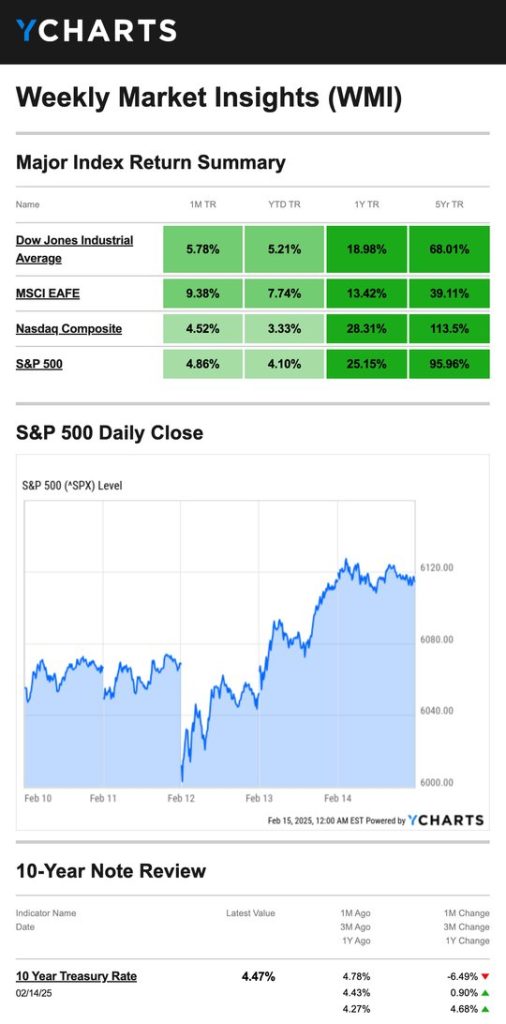By: Gerry Sparrow
Stocks advanced last week despite some intra-week volatility as investors showed concern about the economy’s strength.
The Standard & Poor’s 500 Index gained 1.47 percent, while the Nasdaq Composite Index picked up 2.58 percent. The Dow Jones Industrial Average added 0.55 percent. The MSCI EAFE Index, which tracks developed overseas stock markets, tacked on 2.53 percent.1,2
The Fed Is in “No Hurry”
Stocks opened the week higher, quickly discounting news that the White House would impose 25 percent tariffs on all steel and aluminum imports. Tuesday was a volatility session, punctuated by comments from Fed Chair Powell, who told lawmakers the central bank doesn’t “need to be in a hurry” to lower interior rates further.3,4
Stocks opened lower Wednesday after a warmer-than-expected update on consumer prices. But stocks showed some resilience and rallied throughout the day. The Nasdaq managed to claw back its losses before Wednesday’s close.5
On Thursday, the White House announced a plan for reciprocal tariffs (levies on goods imported into the U.S. from countries that impose tariffs on U.S.-exported goods). But markets rallied on news that the administration would pause tariffs until they determine how much to levy on each country. Stocks took a breather on Friday, shrugging off a weaker-than-expected retail sales report.
The S&P ended shy of a record close, and the Nasdaq finished the week above the 20,000 mark.6

Source: YCharts.com, February 15, 2025. Weekly performance is measured from Monday, February 10, to Friday, February 14. TR = total return for the index, which includes any dividends as well as any other cash distributions during the period. Treasury note yield is expressed in basis points.
Inflation in Focus
The Consumer Price Index report showed prices rose 0.5 percent in January–slightly hotter than expected. Shelter costs remained elevated, increasing 0.4 percent for the month.
Core CPI, which excludes volatile food and energy prices, was also above forecast. Food prices rose 0.4 percent, pushed by a 15.2 percent increase in egg prices related to ongoing issues forcing farmers to cull chicken flocks. Energy prices picked up 1.1 percent as gasoline prices rose.7,8
This Week: Key Economic Data
Tuesday: Homebuilder Confidence Index. San Francisco Fed President Mary Daly speaks.
Wednesday: Housing Starts & Building Permits. Minutes from January Fed meeting.
Thursday: Weekly Jobless Claims. Leading Economic Indicators. Fed Officials Austan Goolsbee and Alberto Musalem speak.
Friday: Existing Home Sales. Consumer Sentiment.
Source: Investors Business Daily – Econoday economic calendar; February 14, 2025
The Econoday economic calendar lists upcoming U.S. economic data releases (including key economic indicators), Federal Reserve policy meetings, and speaking engagements of Federal Reserve officials. The content is developed from sources believed to be providing accurate information. The forecasts or forward-looking statements are based on assumptions and may not materialize. The forecasts also are subject to revision.
Originally posted on February 18, 2025
PHOTO CREDIT: https://www.shutterstock.com/g/Roman+Samborskyi
VIA SHUTTERSTOCK
Footnotes and Sources
1. The Wall Street Journal, February 14, 2025
2. Investing.com, February 14, 2025
3. MarketWatch.com, February 10, 2025
4. CNBC.com, February 11, 2025
5. The Wall Street Journal, February 12, 2025
6. CNBC.com, February 14, 2025
7. The Wall Street Journal, February 12, 2025
8. MarketWatch.com, February 10, 2025
DISCLOSURES
Investing involves risks, and investment decisions should be based on your own goals, time horizon, and tolerance for risk. The return and principal value of investments will fluctuate as market conditions change. When sold, investments may be worth more or less than their original cost.
The forecasts or forward-looking statements are based on assumptions, may not materialize, and are subject to revision without notice.
The market indexes discussed are unmanaged, and generally, considered representative of their respective markets. Index performance is not indicative of the past performance of a particular investment. Indexes do not incur management fees, costs, and expenses. Individuals cannot directly invest in unmanaged indexes. Past performance does not guarantee future results.
The Dow Jones Industrial Average is an unmanaged index that is generally considered representative of large-capitalization companies on the U.S. stock market. Nasdaq Composite is an index of the common stocks and similar securities listed on the NASDAQ stock market and is considered a broad indicator of the performance of technology and growth companies. The MSCI EAFE Index was created by Morgan Stanley Capital International (MSCI) and serves as a benchmark of the performance of major international equity markets, as represented by 21 major MSCI indexes from Europe, Australia, and Southeast Asia. The S&P 500 Composite Index is an unmanaged group of securities that are considered to be representative of the stock market in general.
U.S. Treasury Notes are guaranteed by the federal government as to the timely payment of principal and interest. However, if you sell a Treasury Note prior to maturity, it may be worth more or less than the original price paid. Fixed income investments are subject to various risks including changes in interest rates, credit quality, inflation risk, market valuations, prepayments, corporate events, tax ramifications and other factors.
International investments carry additional risks, which include differences in financial reporting standards, currency exchange rates, political risks unique to a specific country, foreign taxes and regulations, and the potential for illiquid markets. These factors may result in greater share price volatility.
Please consult your financial professional for additional information.
This content is developed from sources believed to be providing accurate information. The information in this material is not intended as tax or legal advice. Please consult legal or tax professionals for specific information regarding your individual situation. This material was developed and produced by FMG Suite to provide information on a topic that may be of interest. FMG is not affiliated with the named representative, financial professional, Registered Investment Advisor, Broker-Dealer, nor state- or SEC-registered investment advisory firm. The opinions expressed and material provided are for general information, and they should not be considered a solicitation for the purchase or sale of any security.
Important Risk Information
If the adviser’s perceptions of a company’s growth potential are wrong, the securities purchased may not perform as expected, reducing the Fund’s return. Investments in small and midcap companies generally have greater risk and volatility. Diversification does not assure a profit or protect against a loss in a declining market. The fund’s investment objectives, risks, charges and expenses must be considered carefully before investing.




